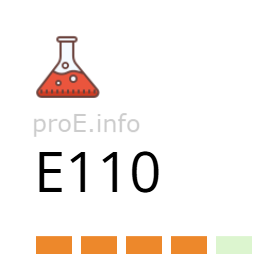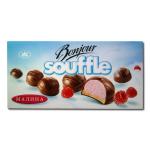
Other names for the additive (synonyms)
General Information
The yellow dye "Sunset Yellow" (food additive E110), also known as "Orange Yellow S", belongs to the group of water-soluble azo dyes derived from petroleum. The chemical formula of additive E110 is C16H10Na2O7S2N2.
The synthetic dye E110 is especially effective for coloring products that undergo fermentation during heat treatment.
Effects on the Body
Risks of additive E110
The dye "Sunset Yellow" (food additive E110) is a sulfonated version of the hazardous dye Sudan I, which is classified as a carcinogen. Therefore, E110 may contain Sudan I as an impurity.
Additionally, E110 itself can cause allergic reactions, especially in individuals with aspirin intolerance. Other side effects of additive E110 may include: nausea, hives (rash), nasal congestion, rhinitis (runny nose), kidney swelling, and chromosomal damage. Additive E110 is often linked to indigestion, vomiting, stomach pain, and food intolerance.
The use of additive E110 in children’s diets should be avoided to prevent hyperactive behavior and reduced attention span. This effect has been scientifically confirmed in recent studies conducted by the UK's Food Standards Agency (FSA).
A number of studies have shown the toxicity of E110 when exceeding the acceptable intake levels. For example, in a study on zebrafish (Danio rerio), scientists found that E110 can cause delayed embryo hatching, heart tumors, reduced heart rate, gallbladder tumors, and skeletal deformities. At very high doses of azo dyes, all embryos died.
This study confirmed the results of previous experiments on E110 in zebrafish.
However, both studies noted that at low doses of the azo dye "Sunset Yellow", no visible developmental abnormalities were observed in embryos.
The EFSA Panel on Food Additives set an acceptable daily intake (ADI) for additive E110 at 4 mg per kg of body weight. When this level is respected, E110 is considered “safe”.
Benefits of additive E110
Due to its synthetic origin, additive E110 is not naturally present in living organisms. Currently, there is no scientific evidence of any benefits associated with the dye "Sunset Yellow".
Uses
Additive E110 is used to color a variety of products: orange squashes, lemon curd, cheese sauces, canned fish, croutons, oriental spices, and packet soups. It is often added to glazes, jams, ice cream, and marmalade. The dye E110 is also used in the production of orange and apricot jellies, hot chocolate, marzipan, as well as soft and alcoholic beverages. It is commonly combined with food additive E123 to achieve brown tones (such as chocolate and caramel color).
Besides the food industry, "Sunset Yellow" is used in pharmaceuticals to color medicinal products and in the production of household cleaning agents.
Legal Status
The dye "Sunset Yellow" (additive E110) was long banned in several European countries, including Finland, Norway, Austria, and Germany. However, after the enforcement of EU Directive 94/36/EC of June 30, 1994, these countries lifted their bans and aligned with European regulations.
The European Union has been actively seeking alternatives to additive E110. Since 2010, all products containing E110 and several other colorants must carry a mandatory warning about their possible effects on children’s hyperactivity.
In 2009, the maximum acceptable daily intake of E110 in Europe was reduced to 1 mg/kg of body weight. However, in 2014 this limit was raised again to 4 mg/kg.
In Ukraine, the United States, Canada, and many other countries, food additive E110 is approved for use in the food industry, provided that maximum allowable limits are observed.

